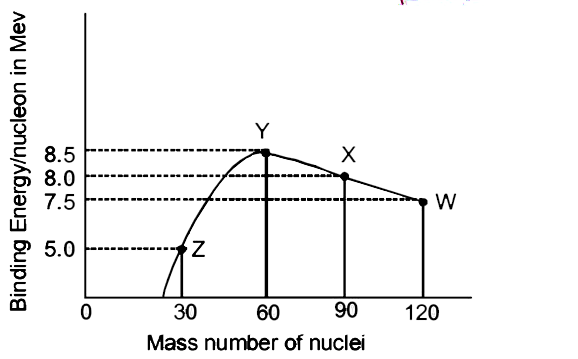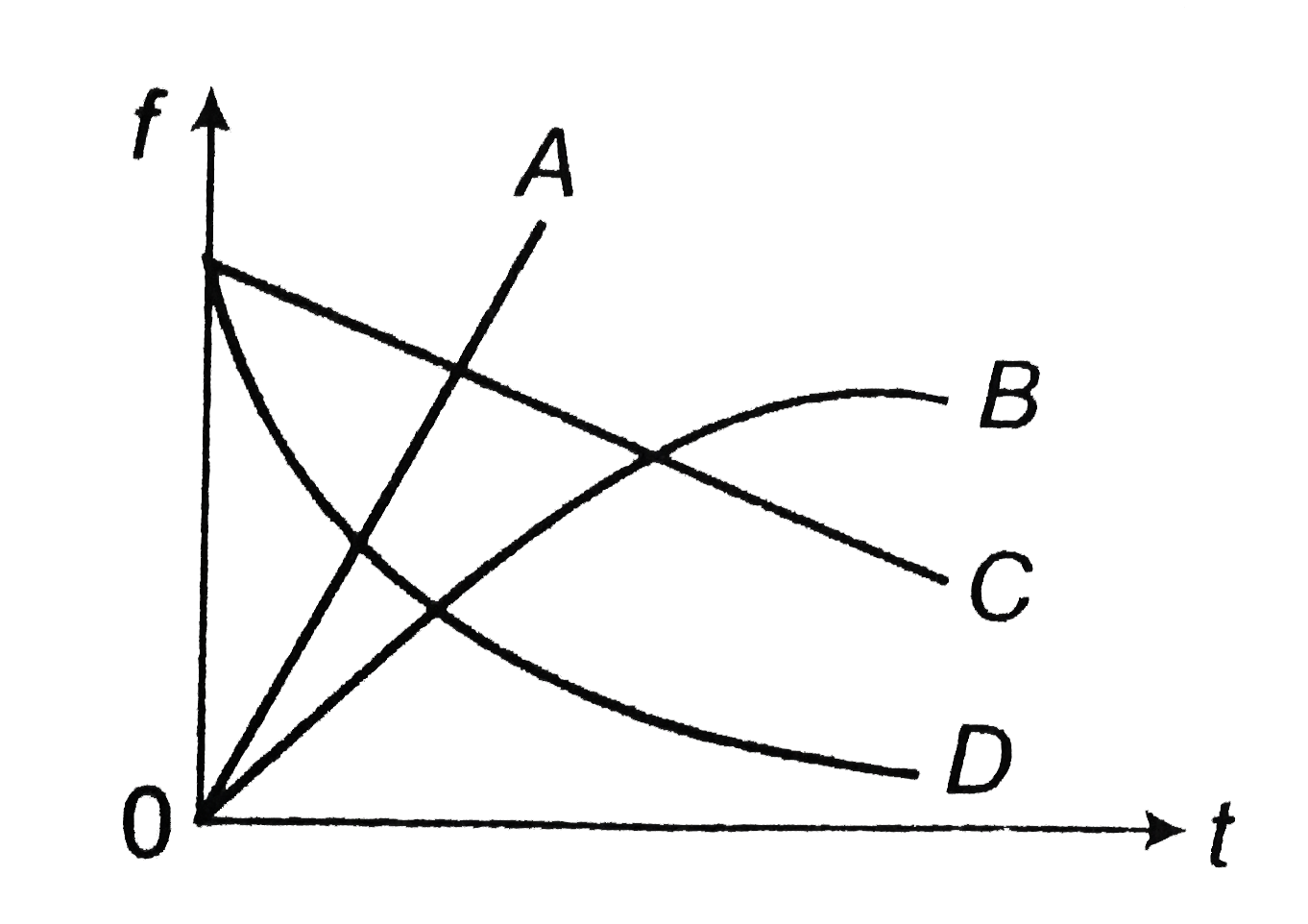Complete Solutions to EXERCISE-4 of chapter NUCLEI of Class 12 book with complete answers and questions
| Class 12 | PHYSICS |
| Chapter | NUCLEI |
| NARAYANA | EXERCISE-4 |
| Number Of Questions | 44 |
| Academic Year | 2023-24 |
Suppose we consider a large number of continers each containing initially `10000` atoms of a radioactive material with a half life of `1` year. After `1` year.
04:59View SolutionWhen a nucleus in an atom undergoes a radioactive decay, the electronic energy levels of the atom -
(A) Do no change for any type of radioactivity.
(B) Change for `alpha` and `beta` -radioactivity but not for `gamma`-radioactivity.
(C) Change for `alpha`-radioactivity but not for others.
(D) Change for `beta`-radioactivity but not for others.02:57View Solution`M_(x) and M_(y)` denote the atomic masses of the parent and the daughter nuclei respectively in a radioactive decay. The Q - value for a `beta-` decay is `Q_(1)` and that for a `beta^(+)` decay is `Q_(2)`. If `m_(e)` denotes the mass of an electrons, then which of the following statements is correct?
04:57View SolutionTritium is an isotope of hydrogen whose nucleus triton contains 2 neutrons and 1 proton . Free neutrons decay into `p+bar(e) +bar(n).` If one of the neutrons in Triton decays , it would transform into `He^(3)` nucleus. This does not happen. This is because
03:45View SolutionHeavy stable nuclei have more neutrons than protons. This is because of the fact that
01:34View SolutionIn a nuclear reactor, moderators slow down the neutrons which come out in a fission process. The moderator used have light nuclei. Heavy nuclei will not serve the purpose because
01:58View Solution`50%` of a radio active substance decays in `5` hours. The time required for the `87.5%` decays is
03:19View Solution`4` grams of radioactive substance `A` left `1//2 gm` after some time . `1` gram of another radioactive substance `B` left `1//4 gm` in the same period, If half life of `B` is `2` hours, the half life of `A` is ( in hours)
02:21View SolutionOne mole of `alpha` emitter of half life equal to `2` days was placed in a sealed tube for `4` days at `S.T.P` volume of helium collector is
03:02View Solution`3` ruthuerfords of a radio active isotope of half-life equal to `3` days was received after `12` days. Initial isotope packed was
02:26View SolutionThe half life of a radio active substance is `6` hours. The amount of the substance undergone disintegration when `36 gms` of it undergoes decay for `18` hours is
01:36View SolutionThe radio active nuclides `A` and `B` have half lives `t` and `2t` respectivey. If we start an experiment with one mole of each of them, the mole ratio after time interval of `6t` will be
01:46View Solution`20%` of a radio active element disintergrates in `1` hr. The percentage of the radio active element disintergrated in `2` hrs will be
02:57View SolutionThe `C^(14)` to `C^(12)` ratio in a certain piece of wood is `25%` of that in atmosphere. The half life period of `C^(14)` is `5,580` years. The age of wood piece is ( in years)
04:31View SolutionA radiactive sample decays by two different processes .Half - life for the first process is `t_(1)` and for the second process is `t_(2)` . The effective half-life is
02:31View SolutionThe age of the wood if only `1//16` part of original `C^(14)` is present in its piece is (in years) ( `T` of `C^(14)` is `5,580` years)
01:52View SolutionA piece of wood is found to have the `(C^(14))/(C^(12))` ratio to be `0.5` times of that in a living plant The number of years back the plant died will be ( `T` of `C^(14)=5,580` years)
01:58View SolutionA piece of wood collected from cro-Magnon caves gave `4` disintergrations`//`min. A freshly cut wood of the same weight gives `16` d.pm. The cro-magnon man lived about ( Half life of `C^(14)` is `5760` years. Assume the activity is due to `C^(14)` only)
02:52View SolutionThe number of `U^(238)` nuclei in a rock sample equal to the number of `Pb^(206)` atoms. The half life of `U^(238)` is `4.5xx10^(9)` years. The age of the rock is
02:11View SolutionEqual masses of two samples of charcoal `A and B` are burnt separately and the resulting carbon dioxide are collected in two vessels. The radioactivity of `^14 C` is measured for both the gas samples. The gas from the charcoal A gives `2100 counts` per week and the gas from the charcoal A gives 2100 counts per week and the gas from the charcoal `B` gives `1400` counts per week. Find the age difference between the two samples. Half-life of `^14 C = 5730 y`.
05:34View SolutionThe half life of a radioactive substance is `20` minutes . The approximate time interval `(t_(2) - t_(1))` between the time `t_(2)` when `(2)/(3)` of it had decayed and time `t_(1)` when `(1)/(3)` of it had decay is
03:36View SolutionA charged capacitor of capacitance C is discharged through a resistance R. A radioactive sample decays with an average-life `tau`.Find the value of R for which the ratio of the electrostatic field energy stored in the capacitor to the activity of the radioactive sample remains constant in time.
07:43View SolutionUranium- `238` decays to thorium-`234` with half-life `5xx10^(9) yr`. The resulting nucleus is in the excited state and hence further emits `gamma`-rays to come to the ground state. It emits `20 gamma`-rays per second. The emission rate will drop to `5 gamma`-rays per second in
02:10View SolutionA sample of radioactive material has mass `m`, decay constant `lambda`, and molecular weight `M`. Avogadro constant `=N_(A)`. The initial activity of the sample is:
01:35View SolutionIf `m g` of a radioactive species (molar mass `M)` has decay constant `lambda` The specis activity of sample at `t = ` is given by:
01:05View SolutionIn moon rock sample the ratio of the number of stable argon-`40` atoms present to the number of radioactive potassium`-40` atoms is `7:1`. Assume that all the argon atoms were produced by the decay of potassium atoms, with a half-life of `2.5xx10^(9)yr`. The age of the rock is
02:47View SolutionThe half-life of a radioactive sample is `T`. If the activities of the sample at time `t_(1)` and `t_(2)` `(t_(1) lt t_(2))` and `R_(1)` and `R_(2)` respectively, then the number of atoms disintergrated in time `t_(2)-t_(1)` is proportional to
02:29View SolutionConsider a hypothetical annihilation of a stationary electron with a stationary positron. What is the wavelength of the resulting radiation?
02:20View SolutionA radioactive nucleus can decay by two different processes. The half life for the first process is `2 t` and that for the second process is `t`. The effective disintergration constant of nucleus is
02:35View SolutionA proton with kinetic energy `K`, strikes another proton at rest. If the collision is head-on, find the correct graph between `K` and the distance of closest approach, `r`.
04:53View SolutionThe fraction quantity of a radiactive sample will decay during half of its half-life period is
02:54View SolutionA small quantity of a solution containing `Na^(24)` radio-nuclide of half-life `T` and activity `R_(0)` is injected into blood of a person. `1 cm^(3)` of sample of blood taken from the blood of the person shows activity `R_(1)`. If the total volume of the blood in the body of the person is `V`, find the timer after which sample is taken.
04:13View SolutionA nucleus with mass number `220` initially at rest emits an `alpha`-particle. If the Q-value of the reaction is `5.5 MeV`, calculate the kinetic energy of the `alpha`-particle.
(a) 4.4 MeV (b) 5.4 MeV (c) 5.6 MeV (d) 6.5 MeV04:26View SolutionSome amount of a radioactive substance (half-life= 10 days) is spread inside a room and consequently the level of radiation becomes 50 times the permissible level for normal occupancy of the room. After how many days the room will be safe for occupation?
02:36View SolutionIn the options given below, let `E` denote the rest mass energy of a nucleus and `n` a neutron. The correct option is:
03:47View SolutionFour different radioactive elements are kept in separated containers. In the beginning the container `A` has `200 g`-atom with half-life of `2` days, `B` has `20 g`-atom with half-life of `20` days, `C` has `2g`-atom with half-life `200` days and `D` has `100g`-atoms wityh half-life of `10` days. In the begining the maximum activity exhibited by the container is
02:11View SolutionBinding energy per nucleons vs mass curve for nucleus is shown in the figure `W,X,Y`and `Z` are four nuclei indicated on the curve . The process that would release energy is
 06:42View Solution
06:42View SolutionWhen `_(3)Li^(7)` nuclei are bombarded by protons , and the resultant nuclei are `_(4)Be^(8)` , the emitted particle will be
01:22View SolutionA sample of uranium is a mixture of three isotopes `._(92)U^(234), ._(92)U^(235)` and `._(92)U^(238)` present in the ratio `0.006%, 0.71%` and `99.284%` respectively. The half lives of then isotopes are `2.5xx10^(5)` years, `7.1xx10^(8)` years and `4.5xx10^(9)` years respectively. The contribution to activity (in `%`) of each isotope in the sample respectively
07:28View SolutionThe table that follows shows some measurements of the decay rate of a sample of `.^(128)I`, a radio nuclide often used medically as a tracer to measure the rate at which iodine is absorbed by the thyroid gland.
`|{:("Time(min)",A (counts//s),"Time(min)",A(counts)//s,),(4,392.2,132,10.9,),(36,161.4,164,4.56,),(68,65.5,196,1.86,),(10,26.8,218,1.00,):}|`

The half life `t_(1//2)` for this radio nuclide.02:24View SolutionThe fraction `f` of radioactive material that has decayed in time `t`, varies with time `t`. The correct variation id given by the curve.
 .02:19View Solution
.02:19View SolutionThe rate of decay `(R )` of nuclei in a radioactive sample is plotted against time `(t)`. Which of the following best represents the resulting curve ?
01:00View SolutionWhat is the probability of a radioactive nucleus to survive one mean life?
01:08View SolutionA radioactive isotope is being produced at a constant rate `dN//dt=R` in an experiment. The isotope has a half-life `t_(1//2)`.Show that after a time `t gtgt t_(1//2)`,the number of active nuclei will become constant. Find the value of this constant.
02:19View Solution
EXERCISE-4 questions and complete solutions for chapter NUCLEI of NARAYANA PHYSICS (HINGLISH) of Class 12
